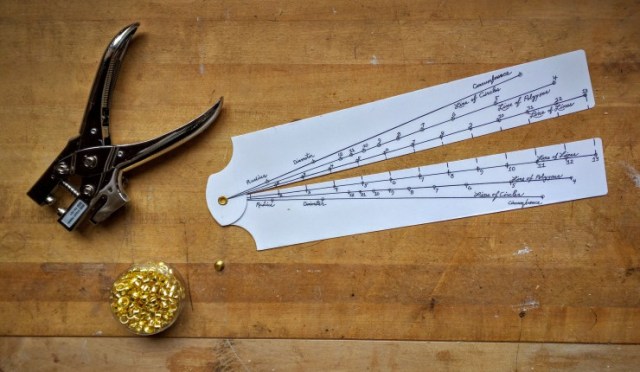
If you haven’t heard of the sector, it probably means you aren’t an artillery officer or a ship’s navigator working in the 17th century. An invention attributed to the great astronomer Galileo, the sector was a calculation instrument comprised of a pair of hinged plates engraved with a variety of scales that – coupled with a pair of dividers – enabled the operator to calculate proportions, polygons, trigonometric and numerous other table functions.
 By the late 1700s, documents show that the sector was also taken up by architects and artisans to lay out designs based on the once ubiquitous whole-number segmentation and ratio-proportioning system of their trade. However, as 19th century machine-based manufacturing eclipsed the traditional practices of the artisans, their design and layout tools – dividers, sectors and applied Euclidian geometry in general – faded almost entirely from use.
By the late 1700s, documents show that the sector was also taken up by architects and artisans to lay out designs based on the once ubiquitous whole-number segmentation and ratio-proportioning system of their trade. However, as 19th century machine-based manufacturing eclipsed the traditional practices of the artisans, their design and layout tools – dividers, sectors and applied Euclidian geometry in general – faded almost entirely from use.
I have discovered, however, that a simple version of the sector can be an incredibly useful and efficient tool for creating scaled drawings (or even doing direct layouts on the stock) when working within traditional design and layout systems. As you may know, George Walker and I describe this system in excruciating detail in our hard-bound book “By Hand and Eye,” and somewhat less-so excruciating in “By Hound and Eye” – the workbook.

With this three-scale sector in one hand and a pair of dividers in the other you’ll find that you can, literally in seconds, create equal segments between two points; derive harmonic proportional relationships along a line or between dimensions; generate angled lines to certain rise-to-run pitches; set out the facets of polygons (up to 12 sides); find the radius to draw arcs of these polygons between any two points; determine the circumference of a circle knowing its radius; and find out what your brother-in-law really does for a living.
Once you start working with our variant of this ancient calculator, you’ll wonder how you ever made do without it.
If you go to the “Shop” page of our By Hand & Eye website you’ll have access to a free-to-download template to make your own sector to play with. Here you’ll also discover a downloadable 40-page pamphlet on using the sector (offered for a small fee to defray expenses and keep George and me off the streets). For those who don’t want to cut out and assemble (i.e. hinge) the template, we also offer an assembled sector (with the “bonus” of being hand signed by George and myself).
— Jim Tolpin, ByHandAndEye.com